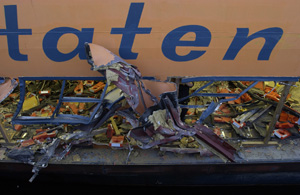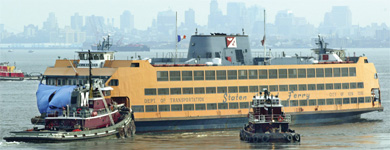Improving the safety of passenger vessels is on the National Transportation Safety Board’s top 10 “most wanted” list for 2014.
Over three decades, accident investigations have shown in numerous cases “that the cause of the accident was not the failure of the vessel, but the lack of good safety practices that led to the loss of life and injuries,” according to the NTSB.
In releasing the list, the NTSB said safety management and the safety culture of the industry need to improve. The NTSB made the following recommendations, which apply particularly to ferries and small passenger vessels: Require fire detection and suppression systems; require voyage data recorders (VDRs) that meet International Maritime Organization standards, and require out-of-water survival craft for all passengers and crew.
“We were very surprised and frankly a bit confused when (the industry) was placed on the NTSB’s ‘most wanted’ list,” said John Groundwater, executive director of the Passenger Vessel Association (PVA). “The important thing is that we were confused because of our commitment to safety, because of our safety culture and because of our record.”
 |
|
Courtesy U.S. Coast Guard |
|
Damage to the ferry’s outside lower level as a result of the crash. |
Passenger vessels and ferries in the U.S. carry about 200 million people a year. Citing U.S. Coast Guard data, the PVA said that between 2000 and 2010 there was an average of fewer than two fatalities a year.
As an example of the difference a safety management system (SMS) can make, the NTSB cited two hard landings of the Staten Island Ferry vessel Andrew J. Barberi.
In 2003, the ferry struck a maintenance pier while docking at Staten Island, killing 11 people. The crash was partly attributed to the New York Department of Transportation’s (DOT) weak safety management, according to the NTSB. After the incident, the DOT implemented a strong safety culture and trained personnel in the procedures for its safety management system. As a result, when Andrew J. Barberi struck the St. George terminal in 2010, personnel carried out effective emergency response procedures that resulted in no deaths and only a few injuries.
Groundwater said the PVA, partnering with the Coast Guard, is developing a voluntary, comprehensive safety management system called Flagship. The program is being beta tested by association members. “Like the NTSB, we are committed to safety — we just disagree sometimes on the way to get there,” he said.
When it comes to voyage data recorders, the NTSB is flexible, said Earl F. Weener, an NTSB board member. “We are more interested in having data recorded on a vessel that allows us to understand the circumstances and facts of the accident,” he said. “That doesn’t necessarily require a full-fledged voyage data recorder.”
Groundwater said the industry welcomes some flexibility when it comes to VDRs. “Fundamentally, we disagree that they have to be on board all vessels,” he said. “We think there are other ways to gather data, for example, through AIS.”
As for the other recommendations, Groundwater said the NTSB is taking the wrong approach. “A one-size-fits-all approach just simply isn’t efficient or appropriate,” he said. “We agree with the Coast Guard — that to properly manage safety you have to do it through risk analysis based on a wide range of operating characteristics, one of which is size.”
Safety management systems can be scaled down to fit small operations, said Weener. “You don’t need a sophisticated software package to do a safety management system,” he said. “It really all goes back to the culture of the operation — how do you really operate the vessel to ensure you are doing it as safely as possible.”

